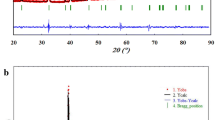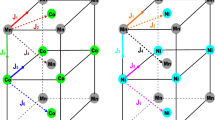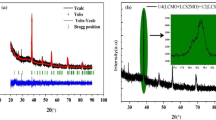Abstract
In this paper, we investigate the effect of nonmagnetic YSZ and magnetic Fe3O4 addition on the magnetocaloric properties of the La0.67Ca0.33MnO3 composite. The temperature dependences of the magnetization for pure LCMO and the impurity doped LCMO composite upon 0.1, 0.3, and 1 T magnetic field were simulated. By the help of the phenomenological model, magnetic entropy change and specific heat for magnetic field variation are predicted. The values of maximum magnetic entropy change, full-width at half-maximum, and relative cooling power were calculated at several magnetic fields. The ΔS M value is 2.45, 2.39, and 5.58 J kg−1 K−1 at 1 T for pristine LCMO, LCMO/YSZ, and LCMO/Fe3O4, respectively.
Similar content being viewed by others
Avoid common mistakes on your manuscript.
1 Introduction
The magnetocaloric effect (MCE) is a property common to all magnetic materials [1]. It is associated with the magnetic entropy change (ΔS M ) that occurs due to a change in an applied magnetic field. This effect is the basis of magnetic refrigeration technology, which promises efficient and environmentally friendly green technology to substitute common vapor-cycle based ones [2, 3]. Since the discovery of the giant MCE in GdGeSi at Ames Laboratory [4], the research on magnetic refrigerant materials has been strongly intensified worldwide. Currently, most research groups study the MCE in rare-earth-based materials because the large moments of the rare-earth atoms imply the possibility of large MCE [5–8]. Rare-earth perovskite manganites of the general formula La1−x Ca x MnO3 have attracted much attention because of their higher potential for magnetic sensor applications based on the magnetoresistance effect. Several researchers have attempted to enhance the CMR effect of manganites by making composites of these materials with secondary phases [9–13]. Additionally, these materials are very convenient for the preparation routes, and their Curie temperature can be justified under the various doping conditions. Therefore, the new trends have been focusing on studying the MCE of manganite composite [14–16]. Due to the large ΔS M , they have been widely used for magnetic refrigeration applications in different temperature ranges.
In this paper, we present the effect of nonmagnetic YSZ and magnetic Fe3O4 dopant on magnetocaloric properties in La0.67Ca0.33MnO3 composite. A pure LCMO prepared by sol-gel method and mixed with YSZ and Fe3O4 according to the nominal formula (1−x)La0.67Ca0.33MnO3+xYSZ (or Fe3O4), where YSZ represents yttria-stabilized zirconia and the doping level of both YSZ and Fe3O4 is 1 mol% [17]. Using the phenomenological model for simulation of the variation of the magnetization with temperature, the magnetocaloric properties such as magnetic entropy change, heat capacity change, and relative cooling power were predicted.
2 Model Calculations
Within the phenomenological model, described in [18], the variation of the magnetization with temperature is represented by
where H max is the maximum external field, T C is a Curie temperature, M i (M f ) is an initial (final) value of magnetization at ferromagnetic–paramagnetic transition as shown in Fig. 1a. Here, \(A = 2( \frac{B - S_{c}}{M_{i} - M_{f}} )\), B magnetization sensitivity dM/dT at ferromagnetic state before transition, S c is magnetization sensitivity dM/dT at T C , and \(C = ( \frac{M_{i} - M_{f}}{2} ) - BT_{C}\).
(a) Temperature dependence of magnetization in constant applied magnetic field. (b), (c), and (d) Magnetization for the LCMO, LCMO/YSZ, and LCMO/Fe3O4 versus temperature at several magnetic fields. The solid lines are modeled results and symbols represent experimental data from [17]
The ΔS can be obtained through the adiabatic change of temperature by the application of a magnetic field. A ΔS as a function of temperature for a field variation from 0 to H max is given by
A more abrupt variation of magnetization near the magnetic transition occurs and results in a large magnetic entropy change. ΔS depends on the temperature gradient of the magnetization and reaches a maximum value around T C .
Relative cooling power is a useful parameter, which decides the efficiency of magnetocaloric materials based on the magnetic entropy change [19, 20]. The RCP is defined as the product of the maximum magnetic entropy change ΔS Mmax and full width at half- maximum in ΔS M (T) curve (δT FWHM). According to this model [18], ΔS Mmax is available by
and δT FWHM is presented by
The RCP is computed by
The RCP corresponds to the amount of heat that can be transferred between the cold and hot parts of the refrigerator in one ideal thermodynamic cycle. This parameter allows an easy comparison of different magnetic materials for applications in magnetic refrigeration; hence, larger RCP values lead to better magnetocaloric materials.
The heat capacity can be calculated from the magnetic contribution to the entropy change induced in the material, ΔC P,H , by the following expression:
From this model [18], a determination of ΔC P,H can be carried out as follows:
3 Simulation
Five parameters can be used to apply the model [18]. M i , M f , and T C parameters were obtained by experimental data in Fig. 1(a) and calculation of magnetization sensitivity at both T C and ferromagnetic state before transition (Sc and B), as displayed in Table 1. Figure 1(b), (c), and (d) show temperature dependences of the magnetization for pure LCMO and the impurity doped LCMO composite upon 0.1, 0.3, and 1 T magnetic fields. The symbols represent experimental data from [17] while the solid line represents modeled data using parameters given in Table 1. The results of calculations and experimental data of magnetization are in good agreement for the composites.
The large magnetocaloric effect in manganites mainly originates from the considerable variation of magnetization near T C [7]. The strong coupling between spin and lattice plays an important role in the magnetic ordering process [21]. In order to understand the influence of the YSZ and Fe3O4 dopant, the magnetic entropy change and heat capacity of the composites have been derived from the simulated magnetization on the basis of Eq. (3) and Eq. (7). respectively. The modeled results for field changes from 0 to 0.1, 0 to 0.3, and 0 to 1 T are shown in Fig. 2 for all materials. The ΔS Mmax value is 2.45, 2.39, and 5.58 J kg−1K−1 at 1 T for pristine LCMO, LCMO/YSZ, and LCMO/Fe3O4, respectively.
The maximum of the magnetic entropy change, full-width at half-maximum, and RCP predicted for composites at several magnetic fields are listed in Table 2. Table 2 summarizes the reported values of magnetic and magnetocaloric parameters obtained by different authors, along with the present data.
As the Fig. 2 shows, anomalies are observed in all curves around T C , which are due to the magnetic phase transition. The value of ΔC P,H changes suddenly from positive to negative around T C and rapidly decreases with decreasing temperature. Furthermore, the maximum and minimum values of ΔC P,H for each sample are determined from Fig. 2 and listed in Table 2.
According to the results, the ΔS and ΔC P,H have been affected by the doped impurities. The doped YSZ (Fe3O4) as a second phase are located mainly at the grain boundaries and/or surfaces of LCMO grains [17]. It is illustrated that Mn spin disorders at the phase interfaces due to which Mn–Mn magnetic exchange is interrupted due to YSZ (or Fe3O4) segregation at the grain boundaries. Due to its very important resistivity [22], a nonmagnetic impurity YSZ for could act as obstacles for the formation of ferromagnetic domains. For the LCMO/Fe3O4, a deviation is seen from the change of the magnetization curve, which may be attributed to the existence of a new magnetic domain related to Fe3O4. It is reported that the magnetic Fe3O4 is related to the improvement of the magnetic homogeneity of the specimens and improves ferromagnetic in nonmagnetic intergrain region. A magnetic impurity is able to participate in the formation of ferromagnetic ordering [22]. With the application of an external magnetic field, the disordered spins can align with each other, as a result producing the large ΔM, hence, large ΔS at low magnetic field.
4 Conclusion
In conclusion, the magnetocaloric response of different impurity La0.67Ca0.33MnO3 composite has been predicted. Improvements in magnetocaloric properties have been observed with Fe3O4 addition in polycrystalline manganites. This result is very important for practical applications because lower fields like 0.1, 0.3, 1 T are much easier to generate by permanent magnets than higher fields like 2 T. So, this model is useful for the development of refrigeration devices and evaluation of its efficiency. We hope this study can stimulate the synthesis and characterization of composites in this series as well as many others in order to check our predictions.
References
Tishin, A.M., Spichkin, Y.I.: The magnetocaloric effect and its applications. Institute of Physics (2003)
Bruck, E.: J. Phys. D, Appl. Phys. 38, R381 (2005)
Phan, M.H., Yu, S.C.: J. Magn. Magn. Mater. 308, 325 (2007)
Pecharsky, V.K., Gschneidner, K.A. Jr.: Phys. Rev. Lett. 78, 4494 (1997)
Hamad, M.A.: Mater. Lett. 82, 181–183 (2012)
M’nassri, R., Cheikhrouhou-Koubaa, W., Koubaa, M., Boudjada, N., Cheikhrouhou, A.: Solid State Commun. 151, 1579 (2011)
M’nassri, R., Cheikhrouhou-Koubaa, W., Chniba-Boudjada, N., Cheikhrouhou, A.: J. Appl. Phys. 113, 073905 (2013)
M’nassri, R., Cheikhrouhou-Koubaa, W., Boudjada, N., Cheikhrouhou, A.: J. Supercond. Nov. Magn. 26, 1429 (2013)
Siwacha, P.K., Srivastav, P., Singh, J., Singh, H.K., Srivastava, O.N.: J. Alloys Compd. 481, 17 (2009)
Lu, W.J., Sun, Y.P., Zhu, X.B., Song, W.H., Du, J.J.: Mater. Lett. 60, 3207 (2006)
Xia, Z.C., Yuan, S.L., Feng, W., Zhang, L.J., Zhang, G.H., Tang, J., Liu, L., Liu, S., Peng, G., Niu, D.W., Chen, L., Zheng, Q.H., Fang, Z.H., Tang, C.Q.: Solid State Commun. 128, 291 (2003)
Xia, Z.C., Yuan, S.L., Zhang, G.H., Zhang, L.J.: J. Phys. D, Appl. Phys. 36, 217 (2003)
Anurag, G., Varma, G.D.: J. Alloys Compd. 453, 423 (2008)
Panwar, N., Coondoo, I., Agarwal, S.K.: J Mater. Lett. 64, 2638–2640 (2010)
Jha, R., Kumar Singh, S., Kumar, A., Awana, V.P.S.: J. Magn. Magn. Mater. 324, 2849–2853 (2012)
Jian, W.: J. Magn. Magn. Mater. 476, 859–863 (2009)
Xia, Z.C., Yuan, S.L., Feng, W., Zhang, L.J., Zhang, G.H., Tang, J., Liu, L., Liu, D.W., Zheng, Q.H., Chen, L., Fang, Z.H., Liu, S., Tang, C.Q.: Solid State Commun. 127, 567–572 (2003)
Hamad, M.A.: Phase Transit. 85, 106–112 (2012)
Pecharsky, V.K., Gschneidner, K.A., Tsokol, A.O.: Rep. Prog. Phys. 68, 1479 (2005)
Gschneidner, K.A. Jr., Pecharsky, V.K.: Annu. Rev. Mater. Sci. 30, 387 (2000)
Guo, Z.B., Du, Y.W., Zhu, J.S., Huang, H., Ding, W.P., Feng, D.: Phys. Rev. Lett. 78, 1142 (1997)
Xia, Z.C., Yuan, S.L., Feng, W., Zhang, L.J., Zhang, G.H., Tang, J., Cheng, L., Zheng, Q.H., Liu, L., Liu, S., Tang, C.Q.: Solid State Comm 126, 567–571 (2003)
Sun, Y., Xu, X., Zhang, Y.H.: J. Magn. Magn. Mater. 219, 183 (2000)
Morelli, D.T., Mance, A.M., Mantese, J.V., Micheli, A.L.: J. Appl. Phys. 79, 373 (1996)
Acknowledgements
This study was supported by the Tunisian Ministry of Higher Education and Scientific Research.
Author information
Authors and Affiliations
Corresponding author
Rights and permissions
About this article
Cite this article
M’nassri, R., Cheikhrouhou, A. Magnetocaloric Effect in Different Impurity Doped La0.67Ca0.33MnO3 Composite. J Supercond Nov Magn 27, 421–425 (2014). https://doi.org/10.1007/s10948-013-2278-1
Received:
Accepted:
Published:
Issue Date:
DOI: https://doi.org/10.1007/s10948-013-2278-1






